May 22, 2020PRESS RELEASE
Development of an unreplicable micro-optical authentication device
- Every pixel with a different spectral fingerprint -
Keyword:RESEARCH
OBJECTIVE.
A group of researchers that included Prof. Yohei Yamamoto of the University of Tsukuba Faculty of Pure and Applied Sciences, Dr. Daichi Okada of the University of Tsukuba Graduate School of Science and Technology (now a researcher at RIKEN), Prof. Masakazu Morimoto of the Rikkyo University College of Science, Prof. Masahiro Irie, guest researcher and deputy director of the Rikkyo University Research Center for Smart Molecules, and Drs. Tadaaki Nagao, Takeo Minari, and Satoshi Ishii, who are group leader, group leader, and senior researcher, respectively at the National Institute for Materials Science, teamed up with scientists at the Leipnitz Institute of Photonic Technology in Germany to develop an unreplicable micro-optical authentication device.
Key points of the study
2. Each microsphere created with these molecules exhibits a unique PL spectrum that can be switched on and off by irradiation with ultraviolet and visible light.
3. These molecules easily self-organize into microspheres on a substrate. Therefore, by optimizing the conditions it is possible to create arrays with various structures.
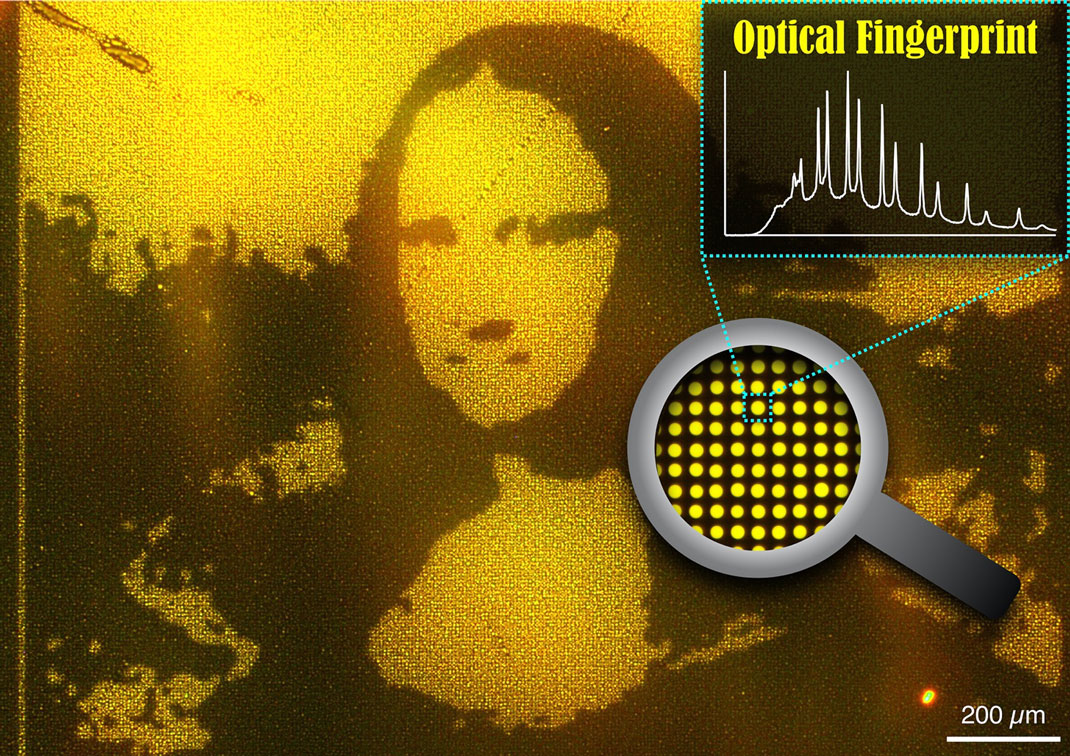
Figure 1. This was used for the back cover image of the journal "Materials Horizons."
* This study was conducted using grant-in-aid for scientific research on innovative areas from the Ministry of Education, Culture, Sports, Science and Technology as part of the π-System Figuration program for "Confining photons in π electron spheres and modulation resonant photoluminescence through various excitation processes," basic research A into "Development of photonic metamaterials by higher linking of photofunctional polymer spheres," bilateral joint research, basic research S, young researcher A, research fellow grants, JST-CREST, NEDO, University of Tsukuba Pre-strategic initiative “Ensemble of light with matters and life,” TIA Kakehashi's "TIA partnership for creating an international research center for cutting-edge optical materials and optical technology," the Asahi Glass Foundation research grant for young researchers, and the Ogasawara Foundation.
Background of the study
Content and findings of the study
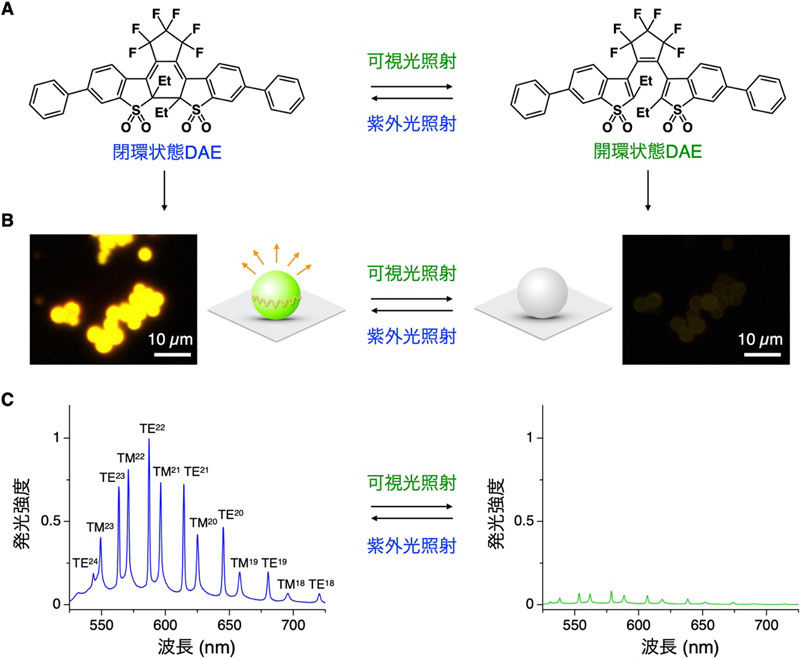
Figure 2. (A) Molecular structure of DAE in closed (left) and open (right) forms. (B) Fluorescence micrographs of DAE microspheres in closed and open forms. Excitation light: 400-440 nm. (C) PL spectra of a single DAE microsphere in closed and open form. Excitation light: 470 nm (picosecond laser).
When the DAE molecules were allowed to self-organize in solution, they formed spheres several micrometers in diameter. Photoexcitation of microspheres composed of closed DAE showed yellow PL (Figure 2B, left). Next, irradiation with visible light changed the microspheres back to the open form and the PL disappeared (Figure 2B, right), confirming irradiation with ultraviolet and visible light could switch the PL on and off. Further, the PL spectra of a single microsphere upon excitation showed a clear WGM pattern (Figure 2C, left), which demonstrated that light was actually confined inside the sphere generating WGM. Continuing to irradiate this particle with visible light caused the WGM PL to nearly disappear, showing that the PL of each particle could be switched on and off (Figure 2C, right).
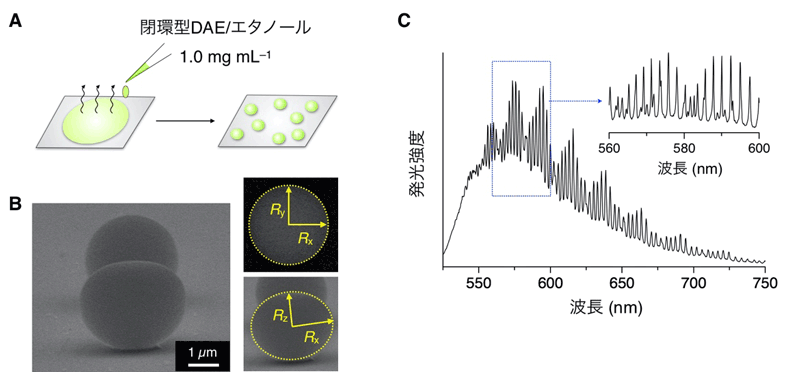
Figure 3 (A, B). Schematic representation and SEM micrograph of oblate ellipsoids self-organized on a substrate. (C) PL spectra of a single oblate ellipsoid particle.
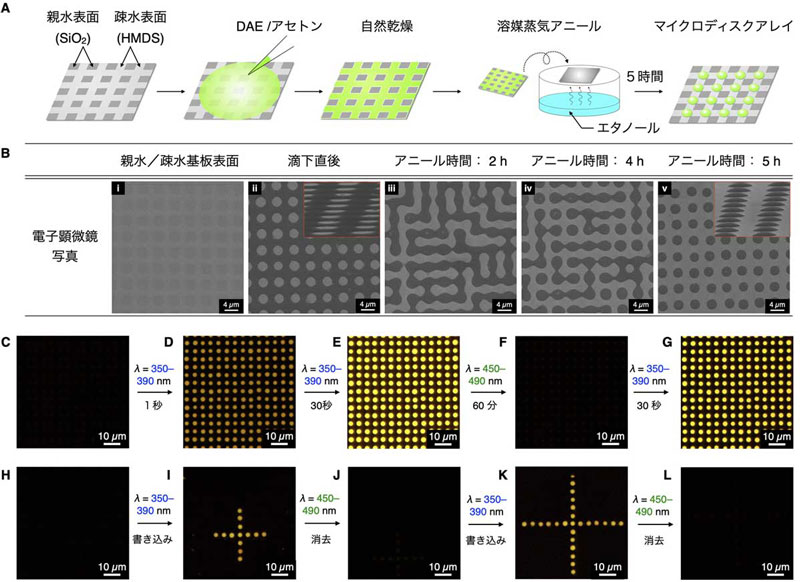
Figure 4 (A). Schematic diagram of the microdisk array fabrication process by drop casting, drying, and solvent vapor annealing of the DAE acetone solution on a substrate surface with a hydrophobic/hydrophilic pattern. (B) SEM micrograph of solvent vapor annealing time dependence in surface self-organization. (C-G) Fluorescence micrographs of an open form DAE microdisk array (C) after 1 second and 30 seconds of ultraviolet light irradiation (D, E), 60 minutes of visible light irradiation (F), and 30 seconds of ultraviolet light irradiation (F). (H–L) Fluorescence micrographs of ultraviolet and visible light irradiation of an open form DAE microdisk array to write and erase a specific pixel.

Figure 5 (A) Schematic diagram of the microhemispherical array fabrication process by drop casting, drying, and immersion in a water/acetone mixed solvent of a DAE toluene solution on a substrate surface with a hydrophobic/hydrophilic pattern. (B) SEM micrographs showing the shapes of the self-organized material with different water/acetone mixing ratios.
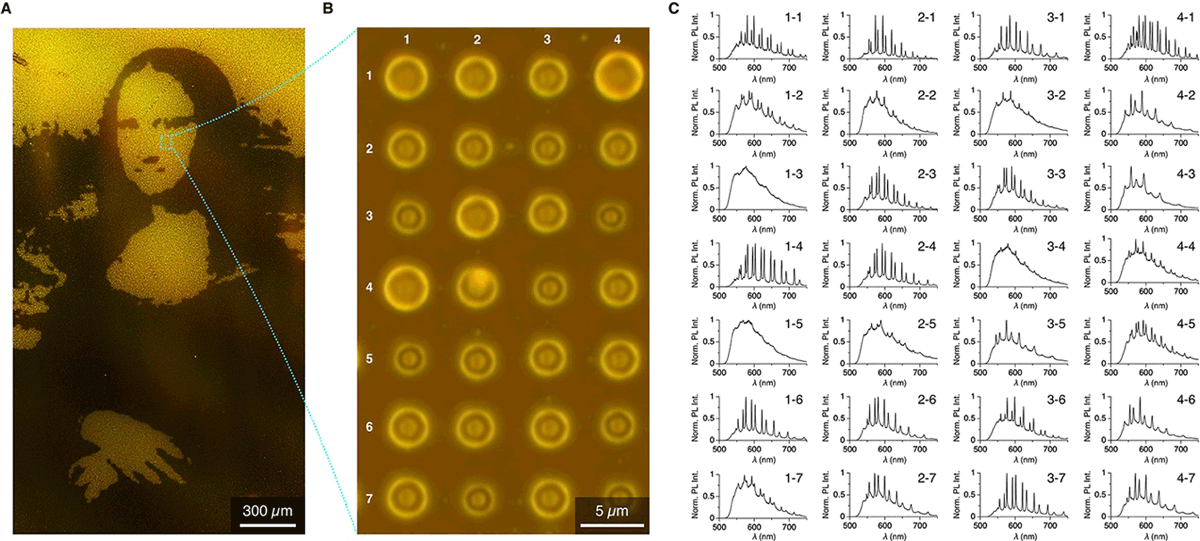
Figure 6 (a) Fluorescence micrograph of an array drawn on a microhemispherical array composed of open form DAE using a photomask (wavelength 350-390 nm, irradiated for 3 minutes, area: 1.6x2.7 mm2). (B) Enlarged image of the cheek of the Mona Lisa (4x7 pixels). (C) PL spectra of each pixel.
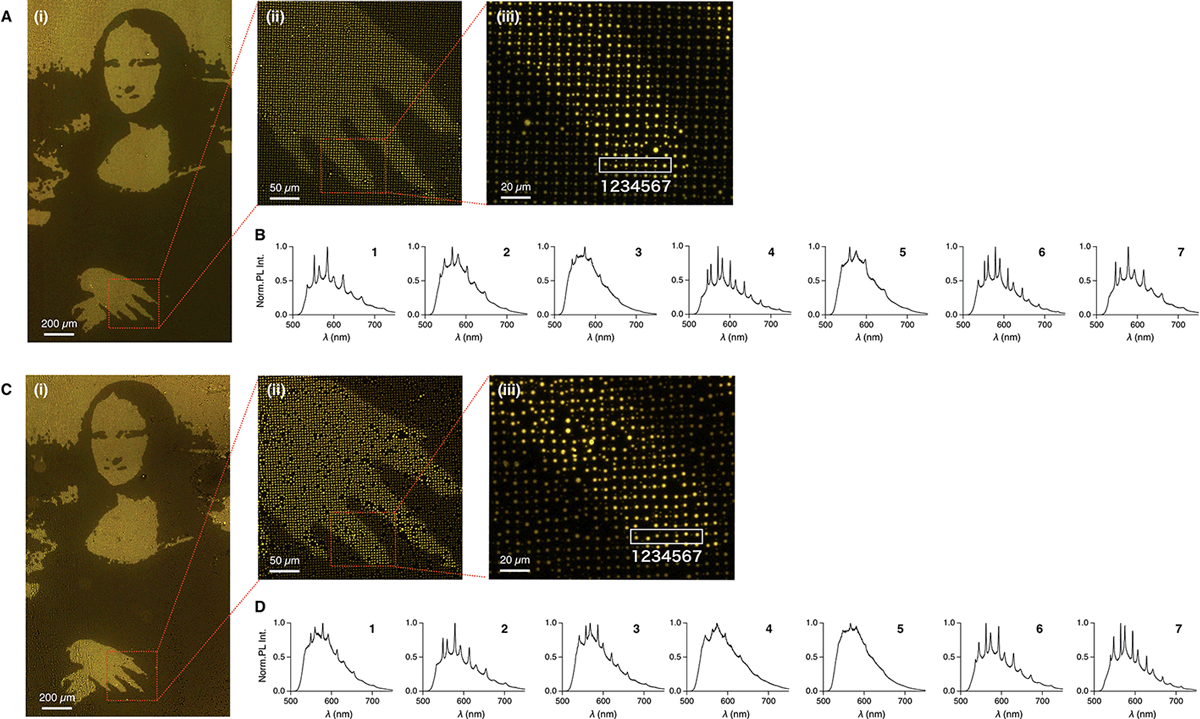
Figure 7 (A, C) Pictures drawn using the same photomask. (B, D) PL spectra of individual pixels in the fingertips.
Future prospects

Figure 8. Shapes, SEM micrographs, and height/diameter ratios of the molecular assemblies formed with each self-organizing method.
Glossary
It was first synthesized and reported in 1988 by Masahiro Irie, who was then at Kyushu University. By appropriately modifying the structure, it is possible to change the color of the open and closed ring structures and the wavelength of light required to induce this change. Because the photochromic phenomenon is reversible even in the crystal state, applications to high-density memory media that use light to read and write reversibly are thought to be possible.
*2: Self-organization
A process in which molecules and other substances spontaneously assemble to form structures.
*3: Microsphere optical resonator
A resonator that confines light inside micrometer-scale spherical structures. A resonator is a container in which standing waves only form and intensify with light of a specific wavelength.
*4: Whispering gallery mode (WGM) resonant photoluminescence
The "Whispering Gallery" is a circular hall at St. Paul's Cathedral in London, where when a whisper is sent along the wall of the inside of the dome, overlapping amplification of multiple sound wave reflex pathways makes the whisper clearly audible to someone on the other side. WGM resonant photoluminescence is when the sound waves in this phenomenon are replaced by light. Because the light wavelengths are much shorter than sound waves, light propagates by total internal reflection inside micrometer-sized spheres or disks, and light resonance is generated at wavelengths that match the phase after one lap, increasing the intensity.
*5: Array
In this paper, an array refers to a structure in which micrometer-scale structures are arranged on a substrate surface.
*6: Pixel
The smallest unit of a digital image. When a digital image is enlarged to the maximum limit, it consists of individual dots containing color data.
*7: QR code
A matrix-type 2-dimensional code invented by the development department of the auto parts manufacturer DENSO Corp. QR stands for "quick response."
*8: Physical unclonable function (PUF)
A function that outputs device-specific values using difficult-to-replicate physical properties. These include variations in the performance of transistors, the fiber structures of paper, the diffusion patterns of a laser passing through a light-transmissible device containing impurities, and the changes in the capacitance of a dielectric scattered with fine particles.
*9: Solvent vapor annealing
A process in which a sample is exposed to the vapor of a solvent, which promotes spontaneous changes in the integrated and assembled structures of molecules.
*10: Microdisk array
A micrometer-scale disk arranged on a substrate surface.
References
[2] M. Irie and M. Morimoto, “Photoswitchable Turn-on Mode Fluorescent Diarylethenes: Strategies for Controlling the Switching Response” Bull. Chem. Soc. Jpn. 2018, 91, 237–250.
Published article
Authors: Daichi Okada, Zhan-Hong Lin, Jer-Shing Huang, Osamu Oki, Masakazu Morimoto, Xuying Liu, Takeo Minari, Satoshi Ishii, Tadaaki Nagao, Masahiro Irie, Yohei Yamamoto
Journal: Materials Horizons (DOI: 10.1039/D0MH00566E)